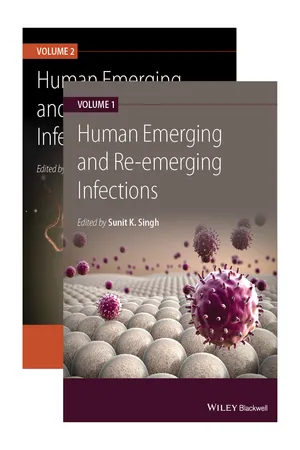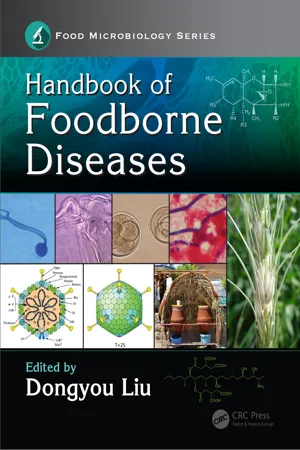Biological Sciences
Chagas Disease
Chagas disease is a tropical parasitic infection caused by the Trypanosoma cruzi parasite. It is primarily transmitted to humans through the bite of infected triatomine bugs, but can also be spread through blood transfusions, organ transplantation, and from mother to baby during pregnancy. The disease can cause serious cardiac and gastrointestinal complications if left untreated.
Written by Perlego with AI-assistance
Related key terms
4 Key excerpts on "Chagas Disease"
- Sunit Kumar Singh(Author)
- 2015(Publication Date)
- Wiley-Blackwell(Publisher)
Chapter 19 Pathogenesis of Chagas Disease in Humans María-Jesús Pinazo1 , Faustino Torrico2 , and Joaquim Gascón11 Global Health Institute (ISGlobal), Hospital Clínic-Universitat de Barcelona, Barcelona, Spain2 School of Medicine, San Simón University (UMSS), Cochabamba, Bolivia19.1 Introduction
Chagas Disease, or American trypanosomiasis, is a zoonotic disease originally from Latin America, caused by the parasite Trypanosoma cruzi (T. cruzi). Chagas Disease is the third most common parasitic infection worldwide, the most important in Latin America, and an emerging disease in Spain, the United States, and other non-endemic countries. According to the Pan American Health Organization (PAHO), around 100 million individuals remained at risk of T. cruzi transmission in endemic countries in 2005 (PAHO, 2006).Chagas Disease is related to poverty. The living conditions of the poor (both in terms of illiteracy and habitat) predispose them to the disease, which in turn influences the quality of life of the people affected. The disease is estimated to be responsible for the loss of 806,170 disability-adjusted life years (DALYs) annually (Lee et al., 2013).Chagas Disease is a “neglected disease” (Hotez et al., 2007). Scientifically described by Carlos Chagas in 1909, it has not been a priority for the governments of affected countries until recently, when several vector control programs were carried out. The persistence of poor social conditions, vector transmission, and the dominance of the autoimmune theory has for decades resulted in an oversight in both the treatment of chronic patients and research of new tools to treat them (Kierszenbaum, 2005).The global economic burden of Chagas Disease is calculated to be $7.19 billion per year, similar or worse than other well-known diseases like rotavirus or cervical cancer (Lee et al., 2013). However, the amount of research funding for Chagas Disease is around 1% of global R&D funding (Moran et al., 2012).- eBook - ePub
- Dongyou Liu(Author)
- 2018(Publication Date)
- CRC Press(Publisher)
60 Trypanosoma cruzi Paula Andrea Jiménez, Jesus Eduardo Jaimes, and Juan David RamírezContents 60.1Introduction 60.2Classification, Morphology, and Structure 60.3Biology and Life Cycle 60.4Transmission Mechanisms 60.4.1Vector Transmission 60.4.2Transfusion Transmission 60.4.3Vertical Transmission 60.4.4Transplantation of Organs 60.4.5Oral Transmission 60.5Epidemiology 60.6Clinical Features 60.6.1Acute Phase 60.6.2Acute Congenital Phase 60.6.3Chronic Phase 60.6.3.1Undifferentiated or Asymptomatic Chronic Phase 60.6.3.2Chronic Symptomatic Phase 60.7Pathogenesis 60.7.1Innate Immunity 60.7.2Acquired Immunity 60.7.2.1Humoral Immunity 60.7.2.2Cellular Immunity 60.8Diagnosis 60.8.1Direct Parasitological Methods 60.8.1.1Fresh Examination 60.8.1.2Thick Drop 60.8.1.3Strout 60.8.1.4Microstrout 60.8.2Indirect Parasitological Methods 60.8.2.1Xenodiagnosis 60.8.2.2Hemoculture 60.8.3Serological Methods 60.8.3.1Indirect Immunofluorescence 60.8.3.2Enzyme-linked Immunosorbent Assay 60.8.3.3TESA Blot 60.8.4Molecular Diagnosis 60.9Treatment 60.10Prevention 60.11Conclusion and Future Perspectives References60.1IntroductionChagas Disease or American trypanosomiasis is a zoonosis caused by the flagellate protozoan Trypanosoma cruzi , named in honor of the Brazilian physician and researcher Carlos Ribeiro Justiniano Chagas in 1909, who recognized the presence of the parasite in a rural population [1 ]. However, paleoparasitology has revealed the presence of the parasite DNA in human mummies more than 9000 years old [2 ]. This disease is endemic to Latin America, where there are more than 120 species of vectors (insects) belonging to the subfamily Reduviidae able to transmit the parasite. Likewise, this parasite has different life stages together with a great adaptability to survive in different hosts, including various mammals due to numerous transmission routes (vector, oral, congenital, blood transfusion, organ transplantation, and laboratory accidents) that have emerged due to urbanization and globalization. At present, the disease is considered a public health problem around the world. T. cruzi is a heterogeneous parasite with seven subtypes (called discrete typing units [DTUs]) including TcI (TcI-Silv and TcI-Dom), TcII, TcIII, TcIV, TcV, TcVI, and TcBat, a recently identified genotype associated with bats [3 ,4 - Fernando De Maio, Ignacio Llovet, Graciela Dinardi(Authors)
- 2020(Publication Date)
- Routledge(Publisher)
Opposing the statist position, Davies (2010) defines the globalist tradition. This perspective is more strongly tied to the global discourse on human rights and social justice. From this position, disease is seen from the perspective of individuals and marginalized populations, and it need not threaten non-endemic countries to be deemed a political priority. The HIV/AIDS literature is clear that securitization of disease is a nuanced and complex process, bringing benefits and limitations. How this framing process will unfold with NTDs is uncertain – though as examined below, recent attention devoted to the ‘globalization’ of Chagas to non-endemic countries indicates that the statist perspective may be growing in importance.Chagas Disease
Chagas Disease is Latin America’s most important parasitic disease (WHO 2010; Llovet, Dinardi, and De Maio 2011). It is spread primarily by a ‘kissing bug’; these blood-sucking triatomine insects live in crevices of the walls and roofs of very poor homes; they thrive in the crooks and gaps left in mud-thatch construction and in walls made of precarious building materials. When they bite they defecate into the bite wound, and in doing so can transmit a parasite (Trypanosoma cruzi; T. cruzi) into its victim, leading to Chagas Disease. Chagas infection is followed by two phases: acute and chronic. The acute phase can last from 4–8 weeks, and is characterized by fever, swollen lymph glands, and often, inflammation at the biting site. Up to 40% of infected people develop chronic Chagas Disease (Reithinger et al. 2009), which is characterized by cardiac and gastrointestinal complications. If left untreated, these can be fatal. In disease endemic areas like Bolivia, Paraguay, and northern Argentina, Chagas is the leading factor in cardiovascular deaths (Reithinger et al. 2009). There is concern in the literature; however, over how difficult it is to isolate the cardiovascular effects of T. cruzi- Randall T. Hayden, Karen C. Carroll, Yi-Wei Tang, Donna M. Wolk(Authors)
- 2016(Publication Date)
- ASM Press(Publisher)
Elitza S. Theel 1 Bobbi S. Pritt 1 18 Parasites INTRODUCTION Parasites are an important cause of human disease worldwide. Malaria alone was responsible for 584,000 estimated deaths in 2013, while millions of others died from Chagas Disease, African trypanosomiasis, strongyloidiasis, amebiasis, leishmaniasis, ascariasis and schistosomiasis (1). Eleven parasitic infections have been identified by the World Health Organization (WHO) as neglected tropical diseases because they threaten the health of millions of individuals and disproportionately impact impoverished individuals (2). The Centers for Disease Control and Prevention (CDC) has also identified five parasitic infections that have significant public health implications for individuals living in the United States, demonstrating that parasitic infections are not limited to the tropical regions of the world. The clinical severity and outcome of parasitic disease is often dependent on the immune status of the host (Table 1) (3). Humans protect themselves from parasites using a variety of defenses, including nonspecific immunity (e.g., mucosal barriers, pH, temperature), innate mechanisms (e.g., complement, toll-like receptors) and adaptive immune mechanisms (e.g., pathogen-specific humoral and cell-mediated responses). In general, helminths elicit a protective helper T-lymphocyte type 2 (Th2) host response with production of IgE, eosinophilia and mastocytosis (4, 5), while protozoa elicit a humoral and/or cellular immune response that is not generally associated with eosinophilia. Conditions that compromise host immunity, thus making individuals more susceptible to parasitic infections and associated disease complications, include primary or acquired immunodeficiencies, receipt of immunosuppressive therapies, malnutrition, and asplenia. Neonates, the elderly and those with chronic disease may also be at increased risk of acquiring or suffering severe consequences from parasitic infections
Learn about this page
Index pages curate the most relevant extracts from our library of academic textbooks. They’ve been created using an in-house natural language model (NLM), each adding context and meaning to key research topics.



